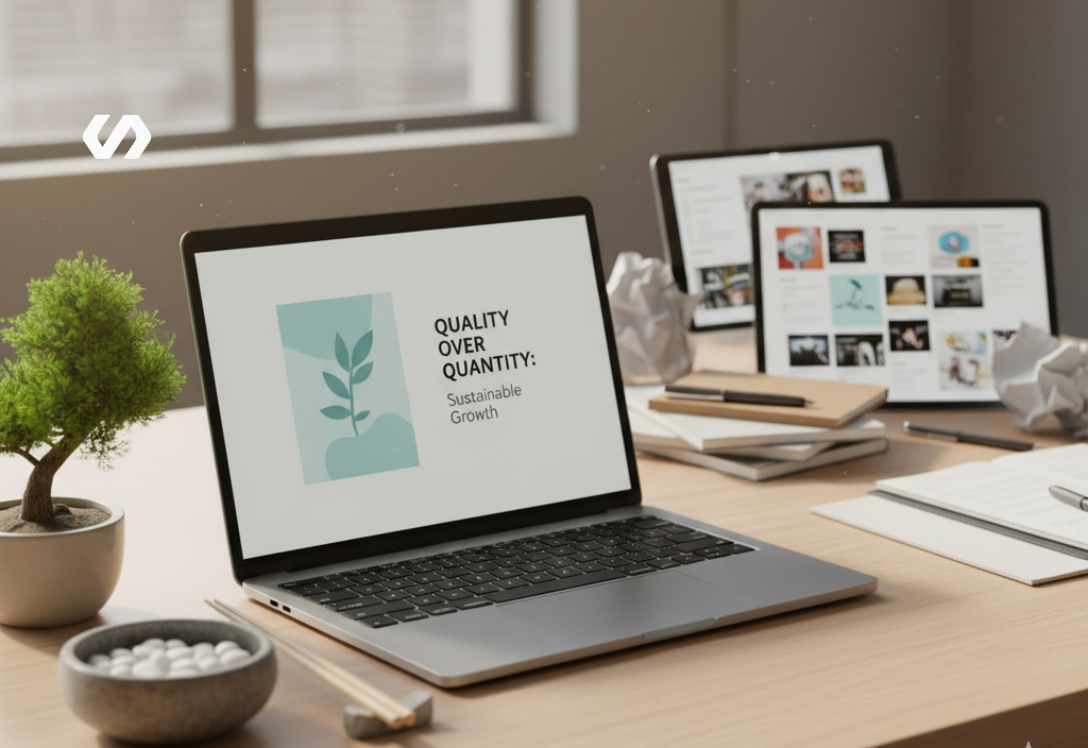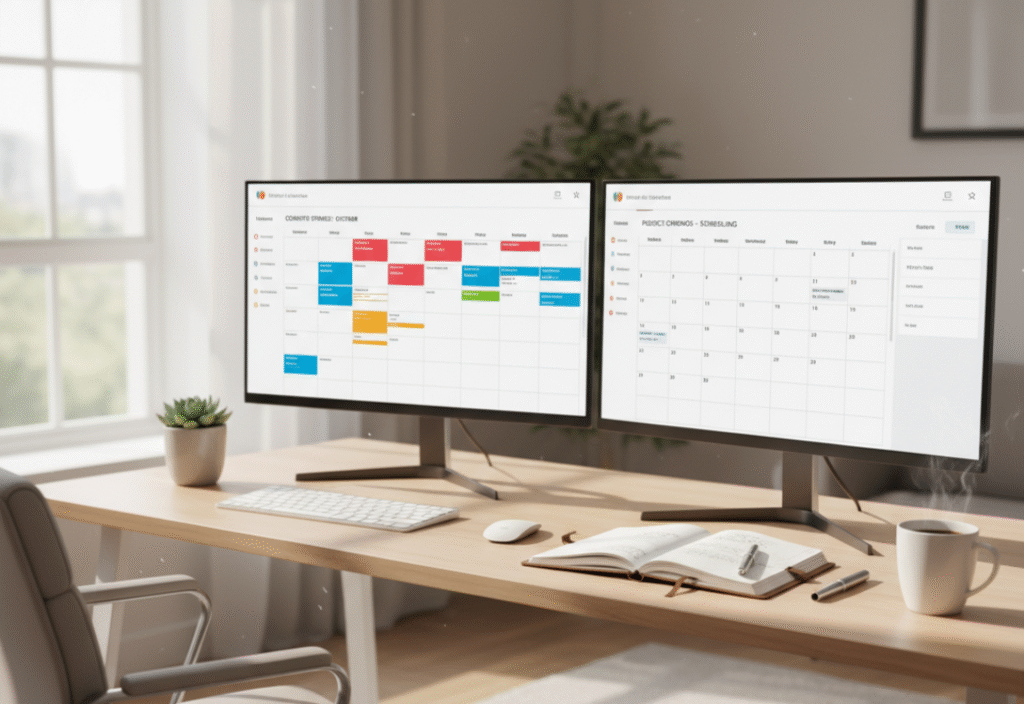It’s 11pm on a Sunday night, and you’re scrambling to create Monday’s social media posts because you “have to post daily or the algorithm will punish you.”
Sound familiar?
You’re exhausted, your content quality is slipping, and despite posting every single day, your engagement isn’t growing. In fact, you’re starting to resent social media altogether.
Here’s the truth that most social media “experts” won’t tell you: the “post daily or die” narrative is burning out Brunei SMEs, destroying content quality, and ironically, hurting the very results you’re chasing.
It’s time to build a social media rhythm that’s actually sustainable.
The Daily Posting Myth (And Why It’s Destroying Your Business)
Let’s dismantle the biggest lie in social media marketing: that you must post every single day to succeed.
This myth persists because it benefits content creation tools, scheduling platforms, and agencies who profit from your anxiety. But the reality? Posting frequency matters far less than you’ve been led to believe.
Think about the Brunei businesses you actually follow and engage with. Do you notice when they skip a day? Do you unfollow them if they post three times a week instead of seven? Of course not. You engage with their content when it’s interesting, valuable, or entertaining, regardless of how often they post.
The algorithm doesn’t reward quantity. It rewards engagement. One post per week that generates meaningful conversations, shares, and saves will always outperform seven forgettable posts that people scroll past without a second thought.
Finding YOUR Right Posting Frequency
Forget what influencers tell you about optimal posting schedules. Here’s how to find your actual sustainable frequency:
Start with your capacity, not your ambition.
Be brutally honest: How many hours per week can you realistically dedicate to content creation? Who’s responsible for this work, and what else is on their plate?
If you can dedicate 3 hours weekly to social media, don’t plan a strategy that requires 10 hours. You’ll fail, feel guilty, and eventually quit altogether.
Calculate backwards from quality.
Ask yourself: How long does it take to create one piece of content you’re genuinely proud of?
If that answer is 30-45 minutes per post, and you have 3 hours weekly, you can sustainably create 4-5 quality posts per week. Not 14. Not 21. Four to five.
Test and measure what actually matters.
Run an experiment: Post at different frequencies for 4-week periods and track engagement rate, direct messages, website traffic, and actual business results.
You might discover that posting 5 times weekly generates only marginally better results than posting 3 times weekly but requires nearly double the effort. That’s valuable data.
The Content Tiers System: Working Smarter, Not Harder
Here’s a framework that lets you maintain consistency without constant pressure: the three-tier content system.
Tier 1: Pillar Content (Weekly) These are your substantial, high-effort pieces. Blog posts, comprehensive guides, customer case studies, major announcements. You create these once per week or even bi-weekly.
Time investment: 1-2 hours each
Impact: High engagement, long-term value, highly repurposable
Tier 2: Standard Content (2-3x Weekly) These are your regular posts: product features, tips, team spotlights, customer testimonials. Solid quality but don’t require extensive research or production.
Time investment: 20-30 minutes each
Impact: Maintains presence, builds familiarity, generates consistent engagement
Tier 3: Micro Content (Daily or As-Needed) These are your Stories, quick updates, reshares, polls, behind-the-scenes moments. Low-effort, authentic, timely content.
Time investment: 5-10 minutes each
Impact: Keeps you visible between main posts, humanizes your brand, creates conversation opportunities
Notice the structure? You’re not creating pillar content daily (that would be exhausting). You’re balancing high-effort pieces with easier content that still adds value.
This system lets you maintain presence without sacrificing quality or your sanity.
When to Automate, When to Stay Manual
Automation can save time, but it can also destroy authenticity if misused. Here’s when each approach works best:
Automate:
- Scheduling feed posts (use Meta Business Suite or similar)
- Posting blog content across platforms
- Sharing evergreen content from your archive
- Cross-posting to multiple platforms (with platform-specific adaptations)
Stay Manual:
- Responding to comments and DMs
- Stories and real-time content
- Commenting on others’ posts
- Community engagement
- Anything tied to current events or timely moments
A practical Brunei example: A local boutique schedules their product showcase posts for Tuesday, Thursday, and Saturday at 7pm. But they personally respond to comments within a few hours and manually post Stories throughout the day showing new arrivals and styling tips. Automated structure, authentic interaction.
Building Systems That Survive Staff Changes
Here’s a scenario that kills many Brunei SMEs’ social media presence: the person handling social media quits, gets sick, or goes on leave, and suddenly everything stops.
Sustainable social media means building transferable systems:
Create a content playbook: Document your brand voice, visual guidelines, content themes, posting schedules, and approval processes.
Build a content library: Maintain a folder of evergreen content, templates, product photos, quotes, and resources that anyone can access and repurpose.
Use consistent templates: Create Canva templates for your most common post types. This ensures brand consistency regardless of who’s creating content.
Establish clear workflows: Who creates content? Who reviews it? Who schedules it? Who handles comments? When these responsibilities are clear and documented, coverage during absences becomes manageable.
Cross-train team members: Even if one person leads social media, at least one other team member should understand the basics.
Measuring What Actually Matters
You can’t build a sustainable rhythm without knowing what success looks like. But most SMEs track vanity metrics that don’t reflect business impact.
Stop obsessing over:
- Follower count (many are inactive or irrelevant)
- Total likes (high likes, zero business impact is meaningless)
- Posting frequency (consistency matters, but not at quality’s expense)
Start tracking:
- Engagement rate (likes + comments + shares + saves ÷ reach)
- Quality of comments (are people asking questions, sharing stories, starting conversations?)
- Direct messages leading to inquiries
- Click-through rates to your website or WhatsApp
- Conversions attributed to social media (appointments, sales, sign-ups)
When you measure impact rather than activity, you can make smart decisions about where to invest effort.
The Permission You’ve Been Waiting For
Here’s what you need to hear:
You have permission to post less frequently if it means posting better content.
You have permission to skip a day when you’re swamped with actual business operations that generate revenue.
You have permission to ignore the “experts” telling you to post 3-5 times daily if that’s unsustainable for your team.
You have permission to prioritize engagement over posting by spending 20 minutes thoughtfully responding to comments rather than creating another post.
Social media is a tool for your business, not a master you serve. The moment it becomes a source of constant stress rather than strategic value, you’ve lost the plot.
Your Sustainable Rhythm Action Plan
Ready to build a social media system you can actually maintain? Here’s your action plan:
Week 1: Audit Your Current Reality How much time are you actually spending on social media? What’s working? What’s not? Be honest about your capacity moving forward.
Week 2: Define Your Sustainable Frequency Based on your capacity and what’s working, what frequency can you maintain indefinitely? Choose a posting schedule you can commit to for 3 months minimum.
Week 3: Implement the Content Tiers System Identify your Tier 1, 2, and 3 content types. Plan how many of each you’ll create weekly. Set up templates for recurring content types.
Week 4: Set Up Your Systems Create a simple content calendar. Build a content library folder. Set up scheduling tools for automation where appropriate. Choose 3-5 meaningful metrics to track weekly.
The Long Game
Sustainable social media isn’t about sprinting. It’s about building a pace you can maintain for years.
The Brunei businesses winning on social media aren’t the ones posting most frequently. They’re the ones showing up consistently, at a quality level their audience values, without burning out their teams in the process.
They understand that three valuable posts per week for 52 weeks (156 high-quality posts) will always outperform daily mediocre posts for 8 weeks before you quit altogether (56 forgettable posts followed by silence).
Social media success is a marathon, not a sprint. And you can’t finish a marathon if you exhaust yourself in the first mile trying to maintain an unsustainable pace.
Build a rhythm that works for your business, your team, and your life. Everything else is just noise.



